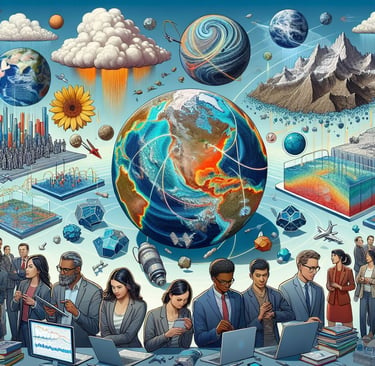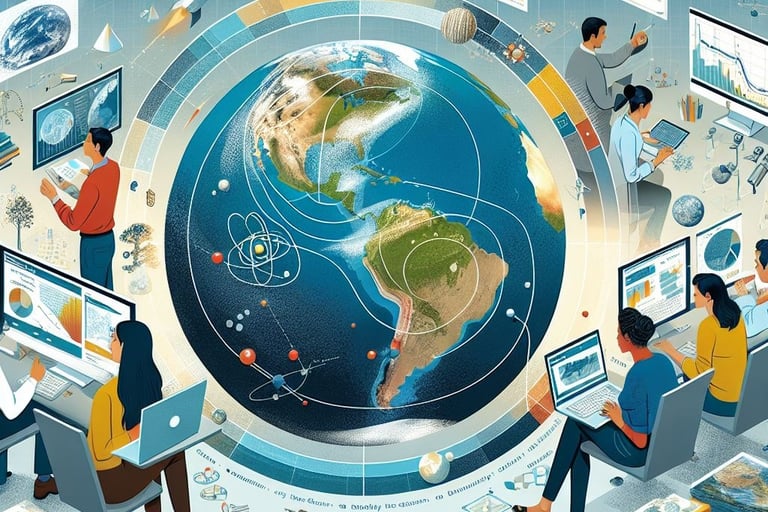Geoscience Foundation Models: A New Paradigm for Earth System Science Education
Xuan-Ce Wang
12/5/20243 min read


Geoscience Foundation Models (GFMs) are transformative tools in Earth system science, offering a cutting-edge approach to understanding the complex dynamics of our planet. By integrating diverse datasets and addressing the multifaceted challenges of traditional models, GFMs open new educational horizons for students and researchers. Below are the key aspects of GFMs and how they enhance geoscience education.
Data Integration
GFMs provide unparalleled opportunities for students to learn about and work with complex datasets.
Multisource Data Integration: Students gain exposure to handling diverse data from satellite observations, geological surveys, and oceanographic instruments, learning techniques to harmonize data from various formats and resolutions.
Data Quality Enhancement: GFMs teach students how to address inaccuracies, missing values, and errors using advanced tools like machine learning, GIS, and data assimilation techniques, fostering critical data evaluation skills.
Scalability and Big Data Processing: Educators can use GFMs to introduce students to scalable data processing methods, preparing them to tackle the ever-growing volumes of geoscience data.
Model Complexity
GFMs provide a framework for teaching multi-scale and interdisciplinary Earth system processes.
Global and Local Insights: Students learn how GFMs model processes at different scales, from global climate patterns to localized environmental changes, emphasizing interconnectedness.
Simulating Earth Systems: GFMs allow students to explore atmospheric dynamics, hydrological cycles, and ecological interactions in a unified manner, promoting holistic system thinking.
Overcoming Computational Challenges: Educational modules can address optimization techniques for GFMs, enabling students to develop solutions for computational constraints.
Interpretability and Validation: GFMs emphasize the importance of model verification and output interpretation, skills critical for building stakeholder trust and ensuring accuracy in scientific models.
Uncertainty Quantification
GFMs offer robust tools for understanding and communicating uncertainty, vital in decision-making and scientific inquiry.
Quantifying and Communicating Uncertainty: Students learn probabilistic modeling, Monte Carlo simulations, and ensemble modeling, developing nuanced insights into variability in Earth systems.
Stakeholder Engagement: Emphasizing transparency, GFMs provide a framework for teaching students how to effectively communicate uncertainties to diverse audiences, enhancing trust and informed decision-making.
Interdisciplinary Collaboration
GFMs serve as a platform for fostering interdisciplinary collaboration, a cornerstone of modern geoscience education.
Cross-Disciplinary Skills: Students engage with methodologies and concepts from climatology, oceanography, ecology, and geology, learning to work across disciplines.
Collaborative Platforms: GFMs offer access to shared databases and integrated modeling tools, preparing students to thrive in team-based research environments.
Privacy, Trust, and Security
As GFMs increasingly rely on large datasets, they provide an excellent context for teaching data ethics and security.
Privacy and Regulation: GFMs introduce students to the ethical management of sensitive data and the importance of regulatory compliance.
Trust-Building Practices: By understanding biases and the need for transparency, students develop a responsible approach to model development and deployment.
Cybersecurity Awareness: Educational programs can leverage GFMs to teach strategies for protecting data integrity and addressing potential cyber threats.
Educational Impact and Future Directions
The integration of GFMs into geoscience curricula empowers students to engage with cutting-edge technology and methodologies, enhancing their ability to tackle pressing global challenges such as climate change, natural hazards, and sustainable resource management. By addressing current challenges—such as computational demands, validation, and ethical concerns—educators and researchers can ensure that GFMs reach their full potential in shaping the future of Earth system science.
GFMs represent not just a technical advancement but a pedagogical innovation, equipping the next generation of geoscientists with the skills and insights needed to understand and protect our planet.
Reference
Zhang H, Xu J J, Cui H W, et al. When geoscience meets foundation models: Towards general geoscience artificial intelligence system[J]. arXiv preprint arXiv:2309.06799, 2023.












